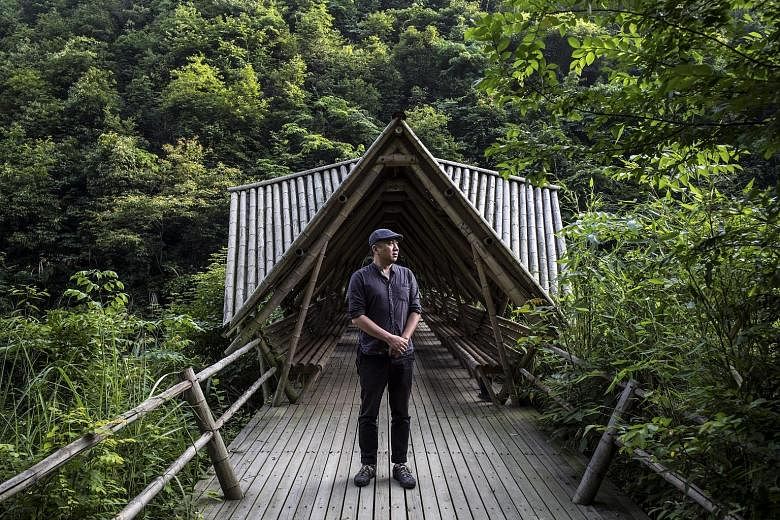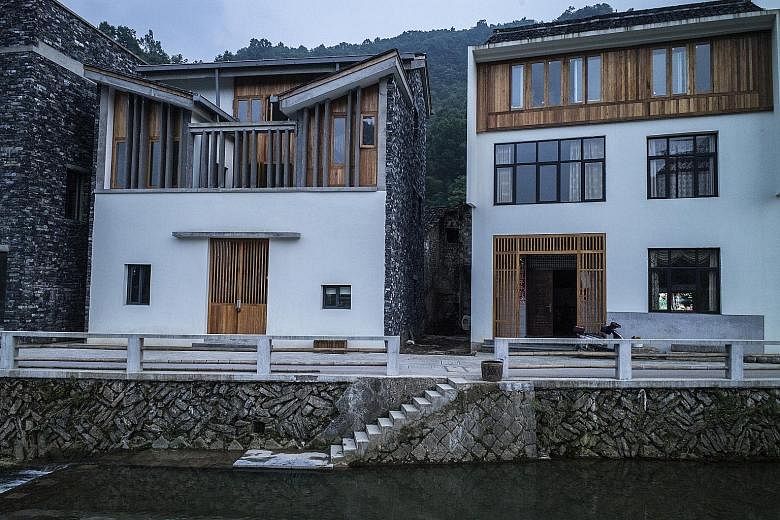LING'AN, CHINA • Nestled in verdant hills amid bamboo forests and feathery grass meadows, the Sun Commune is a thriving eco-farm about 97km from the eastern Chinese city of Hangzhou. Its centrepiece is a pig barn.
Yet this home for 30 or so black hogs is no ordinary outbuilding. An open-air bamboo-lined structure, it has pyramid-shaped thatched roofs and a swimming pool. On a recent afternoon, the swine snoozed to the soothing sounds of soft jazz in their custom-built residence, which has been called China's most beautiful sty.
The sty was designed by Chen Haoru, an architect and professor at the architecture school of the China Academy of Art in Hangzhou. He is part of a wave of architects who, as funding for projects in big cities has dried up in recent years, have turned their attention to China's other frontier: the rural outback.
"Ten years ago, there weren't that many opportunities to do projects in the countryside," Chen said as he led a tour of the Sun Commune grounds. "All of the focus was on the cities."
Several factors have combined to create opportunities for such projects. Restrictions on the transfer of rural land have been relaxed. Urban residents, weary of repeated food safety scares and environmental crises, have become increasingly interested in rural lifestyles and organic farming.
Domestic tourism, bolstered by the growth of the middle class, is booming.
President Xi Jinping has endorsed the shift in emphasis. During a speech in 2013, he called for the construction of a meili xiangcun, or "beautiful countryside", one in which "money is not squandered on unnecessary things" such as tasteless exterior enhancements.
The nature of the projects varies. Some focus on tourism, others on farming or community development.
In addition to Chen's pig barn, notable examples have included a village library near Beijing by Li Xiaodong, a rural community centre and museum in Henan province by He Wei and a rural regeneration project near Hangzhou recently completed by Wang Shu, who was awarded the Pritzker Prize, architecture's equivalent of the Nobel, in 2012.
But they all have a common goal: to revitalise the countryside and enhance its appeal to young people, farmers, visitors and educated workers.
"The most important thing is to make the villages attractive to people again," said Wang, who also teaches at the China Academy of Art.
"The farmers have lost confidence in their own way of life," he added. "They think villages are backward and that cities are good."
He Wei, an architect and professor at the Central Academy of Fine Arts in Beijing, said: "These projects are not just about making beautiful buildings. They're about function and stimulating economic activity."
Opportunities to build in the countryside have expanded even as mass urbanisation continues to hollow out China's villages, with villages being razed to make way for high-rises.
From 2000 to 2010, the number of villages in China dropped to 2.6 million from 3.7 million, a loss of about 300 villages a day, according to research by Tianjin University.
In Zhejiang province, the site of the Sun Commune, thousands of villages have been destroyed.
According to research by Wang, only about 30,000 are left in the province. And most, he said, are in danger of disappearing in the next decade. "Everyone, including the local government, is interested in this topic of how to revive China's villages," he said.
Architects see an opportunity to play a special role in this revitalisation. For one thing, their designs can enhance the reputation of a rural development project and stimulate tourism or agriculture.
That is what Shanghai businessman Chen Wei had in mind when he turned to his friend Chen, the architect, to help him build a barn for pigs as part of his organic farm.
This was in 2013, around the time 16,000 dead pigs were found floating in the nearby Huangpu River after having been dumped by farmers upstream.
"In China, the city people never really interact with rural people, so there's very little social trust," said Mr Chen, the businessman and now the director of the Sun Commune.
"The barn is a major draw - it's part of our brand. It attracts people from the cities to come to the farm so they can actually get to know the people who are growing their food."
NEW YORK TIMES


